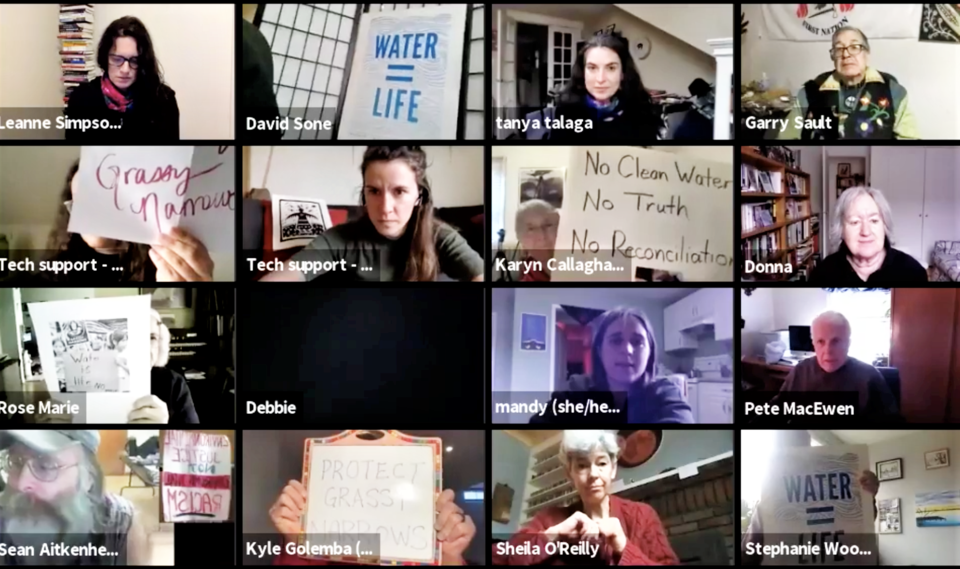GRASSY NARROWS FIRST NATION – Justice for Grassy Narrows First Nation must include financial compensation for the decades-long impacts of mercury poisoning, advocates argued at a virtual rally Saturday.
The rally, organized by community leaders and Free Grassy Narrows activists, looked to spark a campaign boosting awareness of the issue and putting pressure on provincial and federal governments.
Hundreds from across the country tuned in to hear speakers including Tanya Talaga, Leanne Betasamosake Simpson, and Grassy Narrows Chief Randy Fobister, according to organizers.
Fobister acknowledged a significant commitment made by the federal government to build a mercury treatment centre in the community, also known as Asubpeeschoseewagong Netum Anishinabek.
The government initially signed an agreement to spend $19.5 million building the centre in April of 2020, though community leaders remained concerned over a lack of long-term funding.
A commitment of $200 million through 2024-25, and ongoing annual funding of $300,000, was later included in the fall economic statement for two treatment centres in Grassy Narrows and Wabaseemoong Independent Nations, which has suffered similar impacts from industrial pollution of the English-Wabigoon River.
The centre in Grassy Narrows is expected to offer 24 beds.
“There’s some light at the end of the tunnel,” Fobister said. “It’s good to see that. All of the work that everybody’s been doing, the public support – there have been areas where we start to see movement.”
On the issue of compensation, Fobister saw far less movement. Only 14 per cent of Grassy Narrows members had received some form of financial compensation, according to rally organizers.
“Grassy Narrows still needs to gain just compensation for all of its people for the ongoing mercury crisis, to restore their health, way of life, and self-determination, and protect their land and water from industrial logging and mining,” said a statement from the Free Grassy Narrows group, which describes itself as a network of solidarity activists.
A Dryden pulp and paper mill, owned at the time by Reed Paper, discharged tons of mercury-contaminated effluent into the English-Wabigoon River system during the 1960s.
Over 90 per cent of residents in Wabaseemoong and Grassy Narrows continue to show signs of mercury poisoning, researchers have found. Recent studies and reports have suggested there could be ongoing sources of contamination at the mill site.
The provincial government committed $85 million to clean up the river in 2017, though a plan to do the work remains unclear.
The issue is resoundingly personal for Fobister, who described consistently watching community members pass away prematurely.
“Every month we have funerals, maybe two at a time – an elder, a young person,” he said. “I don’t want to start counting. It just keeps on and on. There’s no beginning of when to start grieving, and there’s no end... that’s what’s happening in Grassy Narrows.”
Fobister himself reported experiencing tremors, along with his 18-year-old son.
“When I see my son, his arm is starting to have tremors… what the doctors have said about how it affects embryos – I believe that, because I see it,” he said.
“I am one of those babies that was born with mercury in my blood,” said Chrissy Isaacs, a Grassy Narrows member born in 1979.
Research may not yet have proven she could pass on mercury poisoning to her children, but she believes they both show signs of it.
Everyone in the community needs compensation, she said, not just as a matter of symbolic justice, but to address continuing challenges caused by the poisoning.
“A lot of families struggle with [medical appointments], special education for our children, and also a lot of mental health [impacts],” she said.
Her own application for mercury disability benefits had been denied, she said.
“I have a hard time opening jars,” she said. “I’m starting to have a lot of nerve damage in my body… I see it in a lot of people my age.”
Several speakers said their experiences were often not taken seriously by medical professionals, underscoring the importance of a First Nations-led facility in the community itself.
Doctors can be quick to assume symptoms among Indigenous people are related instead to alcoholism or a bad diet, said Fobister.
Tanya Talaga, journalist and author of Seven Fallen Feathers, said there was a clear case for compensation, and called on non-Indigenous Canadians to support the cause.
“Senator Murray Sinclair once said to me that we, as Anishinaabe people, cannot rely on the good hearts of governments or institutions to just wake up one day and change things,” she said. “We must rely on our teachings… and ourselves to make that change, and the reality is, we cannot do it just by ourselves. We also need to motivate and move the Canadian people – they must stand behind us and help us.”
Organizers mobilized virtual participants Saturday to phone the office of Doug Ford and local MPPs, as well as federal representatives, and to put up posters in their communities.
For Fobister, those efforts are part of a decades-long fight he doesn’t expect to end anytime soon.
“To clean up the mercury itself from the river, that’s going to take many, many, many years,” he said. “In 20 years’ time… I’d like to see the youth drink from the river. That’s my dream, for that to happen again.”
